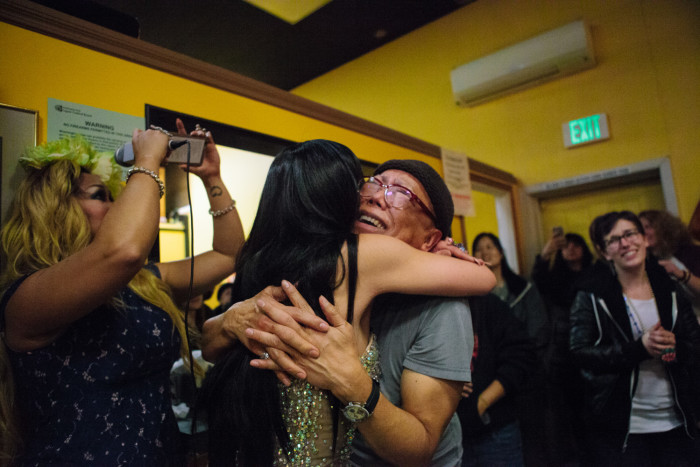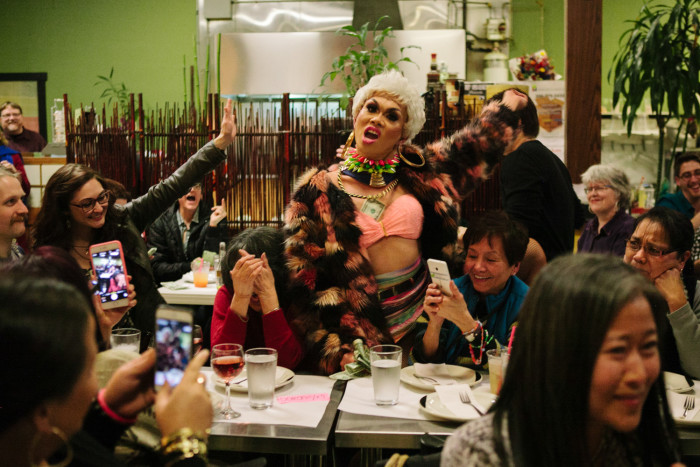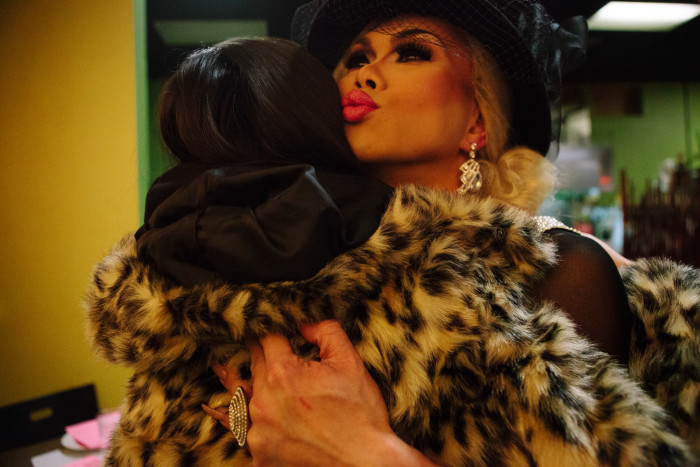
As some of our favorite cultural anchors — restaurants, markets, and other hangout spots — are disappearing, Seattle’s diverse populations continue to get pushed out of the city due to rising rents.
For some like Atasha Alfajora (born male as Louie Alfajora), the Jan. 29 closure of Inay’s Asian Pacific Cuisine on Beacon Hill where she worked, forced her to make one of the most important decisions of her life.
“I recently came out as a trans woman,” she says. “After losing Inays, I wanted to more than just drag.”
A star is born: Atasha Manila unveils herself at Inay’s
Inay’s, a Beacon Hill community anchor and Filipino restaurant, closed its doors after 20-plus years of service due to a rent hike. Many gathered at the final Jan. 29 Friday drag show, hosted by Alfajora, who had been waitressing at Inay’s, for the past seven years.
Alfajora grew into a central part of Inay’s community, earning loyal fans across the city with a drag show she performed every Friday night. The restaurant, which became a home away from home for the budding star, was a major positive milestone in Alfajora’s life.
Inay’s owner Ernesto Rios, known to regulars as “Uncle Ernie,” “witnessed the blooming of Atasha from a very young bud, to a full blown queen,” he says.
“I felt very supported when Uncle Ernie bought me my first dress, like I had a real family that loves me,” Alfajora recalls.

At the age of 18, just a couple of years before she started serving food at Inay’s, she found art in doing make-up professionally after being inspired by Sutan Amrull, also known as Raja, an open trans woman on the show, “America’s Next Top Model,” and makeup artist on RuPaul’s “Drag Race.”
When Alfajora realized that she could transform girls’ faces with her artistic abilities, she wondered what she would look like with makeup on herself.
In 2009, the young makeup artist started working at Inay’s and asked Uncle Ernie if it was possible to put her makeup on in the back of the restaurant. He agreed, and what started out as one hook in the back room where she hung her first dress from Rios, transformed into a full dress closet with an array of vibrant makeup and accessories.
Pretty soon, Louie had a whole wardrobe to work with, dressing up as a woman during his Friday shift at Inay’s, waiting tables in heels and wigs, showing skin and donning anything from suits and neon leopard print, to fur and sequins.

Over the next year or so, this evolved into the drag persona and alter ego Louie created for himself, Atasha Manila. From the moment Atasha took center stage for the first time in June of 2010 singing, “Love You, I do” from”Dreamgirls,” Atasha was a hit.
“I was very fortunate to be given that opportunity, and Uncle Ernie had opened a lot of doors for me by providing a space where I can be myself and practice my art,” she says.
In 2013, Alfajora became an advocate board member at U.T.O.P.I.A. Seattle, (United Territories Of Polynesian Islanders Alliance-Seattle Chapter), a nonprofit organization which holds its largest chapter in Seattle and organizes a “Miss U.T.O.P.I.A.” drag pageant every year. The group consists of mostly Pacific Islanders, and those that work with the group are are mostly trans women, says Alfahora. She was crowned Miss U.T.O.P.I.A. during the organization’s 2014 pageant.
By 2016, Atasha’s performances, regularly packed Inay’s with people and laughter on Friday nights. Atasha also started regular night gigs at R Place Bar & Grill and Neighbours in Capitol Hill.
“She made a big impact and made a big name, not just for Inay’s, but for the whole community,” says Rios. “Inays became so popular on Friday nights for the one-woman drag show,” that he had to turn down customers unless they made reservations, he says.
She was coming into her own. Perhaps Alfahora had found herself, but she was still Louie in the daytime and moonlighting as Atasha at regular night gigs.
But for the most part, she had found home.
Life before Inay’s
Alfajora didn’t always feel this welcome in Seattle.
“Coming from the Philippines at the age of 14, I left my life back home, and it took awhile to gain friends that I really trust and love,” Alfajora explains as she serves us a generous helping of chocolate and fruit inside her immaculate apartment kitchen in Beacon Hill. “The people I have met at Inay’s have been so supportive and loving.”
Alfajora says she always knew that she was different. At age 5, she discovered “I loved Barbie dolls more than I loved trucks.”
She wore clothes made for boys, but used to “hike up my shorts really high and slick my hair back,” she remembers.
Alfajora first became introduced to dressing in drag at the age of 13 when attending Santo Tomas Catholic School in Manila, Philippines — a school run by nuns.
When it came time for students to put on their annual “goodbye” ceremony for the graduating seniors that year, one of the nuns had the idea of having five boys dress up as the Spice Girls for their “farewell” talent show.
Alfajora, who dressed up and performed “Spice Up Your Life” as Sporty Spice, says this show changed her life. It made her realize she had always wanted to dress up and perform as a woman.
While her expression of femininity growing up in Manila was warmly received, Seattle was a different story.
Alfajora immigrated with her family to Seattle in 2002 at the age of 14.
“I was so sad and culture shocked,” she says. “It was so different from what I had. The culture of the Philippines seems more accepting of being who you are.”

In Seattle, it was cold, so Alfajora and her family stayed inside. No one knew their neighbors, and she noticed that students disrespected their teachers, and teachers didn’t punish students when they didn’t turn in their homework, unlike what she experienced as a student in Manila.
During the years of adjusting to life in the U.S., Alfajora concentrated on her school work to stay busy and focus on something other than the absence of her homeland.
A new life after Inay’s
Alfajora, though armed with a strong Pacific Islander and LGBTQ network, as well as a home and community in Beacon Hill, says that when she learned in September 2015 that Inay’s was closing, she started spiraling into depression.
“I didn’t know what depression was until I started feeling this way,” she says. “I was not motivated to do anything. Even though drag makes me happy and making garments make me happy, none of it was working.”
On March 23, 2016, she checked herself into Harborview Medical Center after a suicide attempt.
“After I checked myself in for depression, I felt so lost: losing Inay’s, friends had moved away, the places are changing, and I felt stuck and didn’t know where to go.”
Alfajora says Louie in particular was very unhappy, and “what was keeping Louie happy was Atasha.”
After she checked out of the hospital, she started having anxiety attacks.
“I had my first anxiety attack at R Place, in Capitol Hill. My drag sisters, actually shook me and woke me up, told me to snap out of it and that I had to do what makes me happy,” she says. “A good friend, La Sayviana, told me, ‘Look at yourself: you are a woman. You feel like a woman. You dress like a woman. A woman makes you happy. You can be out of drag, but you are still in high heels and makeup.’”
“When she said this to me, I started laughing, even though I was crying. I knew she was right.”
That night, she finally admitted something to herself.
“I found drag but I forgot about myself,” she explains. “It was such a distraction to what I really wanted. I always wanted to be a woman, and I always wanted to be a girl. It’s what keeps me happy.”
I am no longer a gay boy who dresses up in girl clothes: I am a transgendered woman, and my pronoun is she/her.
In that moment of truth – a few days after checking herself out of the hospital — Alfajora decided to start her physical transition into womanhood.
“I feel like I have more of a direction now that I have identified myself,” she continues to explain. “I am grounded. I am no longer a gay boy who dresses up in girl clothes: I am a transgendered woman and my pronoun is she/her. I will keep going forward.”
Alfajora is now taking the first step in her journey by re-enrolling in an insurance plan that covers hormone therapy for transgender-identified individuals, protected and covered by private insurers under state non-discrimination law and the Affordable Care Act. She hopes to be starting her hormone replacement therapy soon, which averages about $1,500 per year. A two-year hormone treatment process prepares the body for male-to-female gender reassignment surgery, which costs upwards of $30,000.
In discussing her alienation from Louie, Alfajora has started dressing less like her male alter ego in the daytime, and more like the woman she merely moonlighted as at night.
“I always wanted to be a woman, and now I am just living my life as one,” she explains. “I am not in drag, I am simply being myself.”
When Alfajora was attending Santo Tomas Catholic School as a teenager in Manila, she remembers something written on the board during her religion class: “We are all created in God’s image and likeness.” Alfajora has always lived by this motto.
But not everyone sees it this way. Alfahora doesn’t deny the impact of trans hate and violence as a consequence of living as she is.
“It is very tough on trans women. People look. People stare. They say things. It is what what it is,” she says.
“They will never be happy about what they’re doing for themselves, so they hurt other people.”
In the past several years, Seattle has seen the 2014 murders of Ahmed Said and Dwone Anderson-Young, two queer black men; the suicide of trans activist Sun Kim that same year; and the 2011 beating and homicide of Danny Vega in South Seattle.
But since the first dress Uncle Ernie bought her, Alfajora’s womanhood has been fully embraced by her Beacon Hill community, one where she feels safe to transition into who she fully is.
“This world is crazy, but there are great people out there, and that’s what counts,” she says.
Missing Atasha Manila on Friday nights at Inay’s? You can watch her perform at 7 p.m. every Super Gay Wednesday night at Baja Bistro in Beacon Hill.
This story has been updated since its original publication to correct the spelling of the main source’s last name, which is “Alfajora,” not “Alfahora,” as originally published.


Atasha Manila is one of the most amazing people I have ever met. She is sassy and raunchy, and has a heart of gold. Atasha taught me how, after breast cancer treatment, to move forward and be the fabulous woman I am meant to be even if it means wearing fake boobs and hair. Thank you for this beautiful story. And thank you, Atasha, for your beautiful life. Please don’t ever think about taking it from us again.